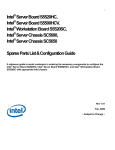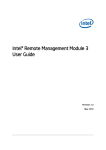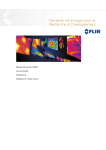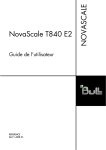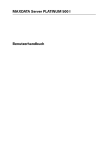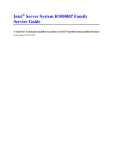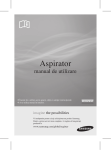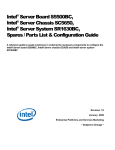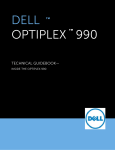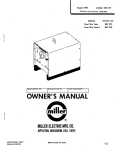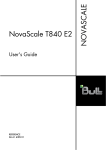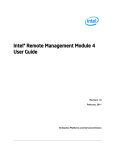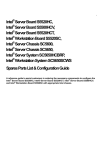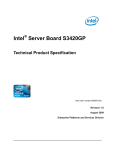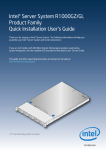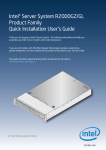Download Intel Server Board S5500BC User's Guide
Transcript
Intel® Server Board S5500BC User’s Guide Intel Order Number E52448-002 Disclaimer Information in this document is provided in connection with Intel® products. No license, express or implied, by estoppel or otherwise, to any intellectual property rights is granted by this document. Except as provided in Intel's Terms and Conditions of Sale for such products, Intel assumes no liability whatsoever, and Intel disclaims any express or implied warranty, relating to sale and/or use of Intel products including liability or warranties relating to fitness for a particular purpose, merchantability, or infringement of any patent, copyright or other intellectual property right. Intel products are not designed, intended or authorized for use in any medical, life saving, or life sustaining applications or for any other application in which the failure of the Intel product could create a situation where personal injury or death may occur. Intel may make changes to specifications and product descriptions at any time, without notice. Intel server boards contain a number of high-density VLSI and power delivery components that need adequate airflow for cooling. Intel's own chassis are designed and tested to meet the intended thermal requirements of these components when the fully integrated system is used together. It is the responsibility of the system integrator that chooses not to use Intel developed server building blocks to consult vendor datasheets and operating parameters to determine the amount of airflow required for their specific application and environmental conditions. Intel Corporation can not be held responsible if components fail or the server board does not operate correctly when used outside any of their published operating or non-operating limits. Intel, Intel Pentium, and Intel Xeon are trademarks or registered trademarks of Intel Corporation or its subsidiaries in the United States and other countries. * Other names and brands may be claimed as the property of others. Copyright © 2009, Intel Corporation. All Rights Reserved ii Intel® Server Board S5500BC User’s Guide Intel® Server Board S5500BC User’s Guide iii iv Intel® Server Board S5500BC User’s Guide Preface About this Manual Thank you for purchasing and using the Intel® Server Board S5500BC. This manual is written for system technicians responsible for troubleshooting, upgrading, and repairing this server board. This document provides a brief overview of the features of the board/chassis, a list of accessories or other components you may need, troubleshooting information, and instructions on how to add and replace components on the Intel® Server Board S5500BC. For the latest version of this manual, see http://support.intel.com/ support/motherboards/server/S5500BC. Manual Organization Chapter 1 provides a brief overview of the Intel® Server Board S5500BC. In this chapter, you will find a list of the server board features, photos of the product, and product diagrams to help you identify components and their locations. Chapter 2 provides instructions on using the utilities shipped with the board or those required to update the system. This includes how to navigate through the BIOS Setup screens, perform a BIOS update, and reset the password or CMOS. Information about the specific BIOS settings and screens is available in the Technical Product Specification. See “Additional Information and Software” for a link to the Technical Product Specification. Chapter 3 provides instructions on adding and replacing components. Use this chapter for step-by-step instructions and diagrams for installing or replacing components such as the memory, front panel board, and the battery, among other components. Chapter 4 provides troubleshooting information. In this chapter, you will find BIOS error messages and POST code messages. You will also find suggestions for performing troubleshooting activities to identify the source of a problem. Product Accessories This server board is compatible with the following Intel® Server Chassis: • Intel® Server Chassis SR1630BC • Intel® Server Chassis SC5650 You may need or want to purchase one or more of the following accessory items for your server: processor, memory DIMMs, hard drive, CD-ROM or DVD-ROM drive, and/or operating system. For information about which accessories, memory, processors, and third-party hardware were tested and can be used with your board, and for ordering information for Intel products, see: http://support.intel.com/support/motherboards/server/S5500BC Additional Information and Software If you need more information about this product or information about the accessories that you can use with this server board, use the following resources. These files are available at: http://support.intel.com/support/motherboards/server/S5500BC/ Unless otherwise indicated in the following table, once on this webpage, type the document or software name in the search field at the left side of the screen and select the option to search “This Category” and then click Search. For this information or software vi Use this Document or Software For in-depth technical information about this product, including BIOS settings and chipset information Technical Product Specification If you just received this product and need to install it Intel® Server Board S5500BC Quick Start User's Guide in the product box Accessories or other Intel server products Spares and Configuration Guide Hardware (peripheral boards, adapter cards) and operating systems that were tested with this product Tested Hardware and Operating System List Chassis tested with this product Reference Chassis List http://serverconfigurator.intel.com Intel® Server Board S5500BC User’s Guide For this information or software Processors tested with this product Use this Document or Software Supported Processors The latest supported memory configurations lists are available at: http://serverconfigurator.intel.com/configurememory.aspx?id=MTY2MyMxLDI1MTYjMSwyNjIw IzIsMjUzMiMx DIMMs tested with this product Supported Memory To make sure your system falls within the allowed power budget Power Budget For software to manage your Intel® server Intel® Server Management Software For drivers • • Driver (for an extensive list of drivers available) Operating System Driver (for operating system drivers) For firmware and BIOS updates Firmware Update For diagnostics test software Diagnostics Intel® Server Board S5500BC User’s Guide vii viii Intel® Server Board S5500BC User’s Guide Safety Information Important Safety Instructions Read all caution and safety statements in this document before performing any of the instructions. See also Intel Server Boards and Server Chassis Safety Information on the Intel® Server Deployment Toolkit 3.0 CD and/or at http://support.intel.com/support/ motherboards/server/sb/cs-010770.htm. Wichtige Sicherheitshinweise Lesen Sie zunächst sämtliche Warnund Sicherheitshinweise in diesem Dokument, bevor Sie eine der Anweisungen ausführen. Beachten Sie hierzu auch die Sicherheitshinweise zu Intel-Serverplatinen und Servergehäusen auf der Intel® Server Deployment Toolkit 3.0 CD oder unter http://support.intel.com/support/motherboards/server/sb/cs-010770.htm. Consignes de sécurité Lisez attention toutes les consignes de sécurité et les mises en garde indiquées dans ce document avant de suivre toute instruction. Consultez Intel Server Boards and Server Chassis Safety Information sur le Intel® Server Deployment Toolkit 3.0 CD ou bien rendez-vous sur le site http://support.intel.com/support/motherboards/server/sb/cs010770.htm. Instrucciones de seguridad importantes Lea todas las declaraciones de seguridad y precaución de este documento antes de realizar cualquiera de las instrucciones. Vea Intel Server Boards and Server Chassis Safety Information en el Intel® Server Deployment Toolkit 3.0 CD y/o en http:// support.intel.com/support/motherboards/server/sb/cs-010770.htm. 䞡㽕ᅝܼᣛᇐ ᠻ㸠ӏԩᣛҸПࠡˈ䇋䯙䇏ᴀ᭛ḷЁⱘ᠔᳝⊼ᛣџ乍ঞᅝܼໄᯢDŽ http://support.intel.com/support/motherboards/server/sb/CS-010770.htmϞⱘ,QWHO 6HUYHU%RDUGVDQG6HUYHU&KDVVLV6DIHW\,QIRUPDWLRQ˄lj,QWHO ᳡ࡵ఼ЏᵓϢ᳡ࡵ఼ᴎㆅᅝֵܼᙃNJ˅DŽ x Intel® Server System SR1630BC User’s Guide Warnings Heed safety instructions: Before working with your server product, whether you are using this guide or any other resource as a reference, pay close attention to the safety instructions. You must adhere to the assembly instructions in this guide to ensure and maintain compliance with existing product certifications and approvals. Use only the described, regulated components specified in this guide. Use of other products / components will void the UL listing and other regulatory approvals of the product and will most likely result in noncompliance with product regulations in the region(s) in which the product is sold. System power on/off: The power button DOES NOT turn off the system AC power. To remove power from system, you must unplug the AC power cord from the wall outlet. Make sure the AC power cord is unplugged before you open the chassis, add, or remove any components. Hazardous conditions, devices and cables: Hazardous electrical conditions may be present on power, telephone, and communication cables. Turn off the server and disconnect the power cord, telecommunications systems, networks, and modems attached to the server before opening it. Otherwise, personal injury or equipment damage can result. Electrostatic discharge (ESD) and ESD protection: ESD can damage disk drives, boards, and other parts. We recommend that you perform all procedures in this chapter only at an ESD workstation. If one is not available, provide some ESD protection by wearing an antistatic wrist strap attached to chassis ground—any unpainted metal surface—on your server when handling parts. ESD and handling boards: Always handle boards carefully. They can be extremely sensitive to ESD. Hold boards only by their edges. After removing a board from its protective wrapper or from the server, place the board component side up on a grounded, static free surface. Use a conductive foam pad if available but not the board wrapper. Do not slide board over any surface. Installing or removing jumpers: A jumper is a small plastic encased conductor that slips over two jumper pins. Some jumpers have a small tab on top that you can grip with your fingertips or with a pair of fine needle nosed pliers. If your jumpers do not have such a tab, take care when using needle nosed pliers to remove or install a jumper; grip the narrow sides of the jumper with the pliers, never the wide sides. Gripping the wide sides can damage the contacts inside the jumper, causing intermittent problems with the function controlled by that jumper. Take care to grip with, but not squeeze, the pliers or other tool you use to remove a jumper, or you may bend or break the pins on the board. Intel® Server System SR1630BC User’s Guide xi xii Intel® Server System SR1630BC User’s Guide Table of Contents Preface.......................................................................................................................... v Manual Organization............................................................................................................... v Product Accessories .............................................................................................................. vi Additional Information and Software...................................................................................... vi Safety Information ....................................................................................................... v Important Safety Instructions ................................................................................................. ix Warnings................................................................................................................................ xi Chapter 1: Server Board Features ............................................................................. 1 Connector and Component Locations ....................................................................................3 Configuration Jumpers............................................................................................................ 5 Back Panel Connectors ..........................................................................................................7 RAID Support.......................................................................................................................... 8 Hardware Requirements.................................................................................................9 Optional Hardware........................................................................................................12 Chapter 2: Hardware Installations and Upgrades .................................................. 13 Before You Begin..................................................................................................................13 Tools and Supplies Needed .........................................................................................13 Installing and Removing Memory .........................................................................................13 Installing DIMMs ...........................................................................................................13 Removing DIMMs .........................................................................................................14 Installing or Replacing the Processor ...........................................................................15 Installing the Processor ................................................................................................15 Installing the Retention Mechanism(s) and Heat Sink(s)..............................................18 Replacing a Processor .................................................................................................19 Installing a PCI Add-In Card .................................................................................................21 Installing a PCI Add-In Card .........................................................................................21 Replacing the Backup Battery ..............................................................................................23 Chapter 3: Server Utilities......................................................................................... 25 Using the BIOS Setup Utility.................................................................................................25 Starting Setup...............................................................................................................25 If You Cannot Access Setup.........................................................................................25 Setup Menus ................................................................................................................25 Upgrading the BIOS..............................................................................................................27 Preparing for the Upgrade ............................................................................................27 BIOS Recovery Mode and BIOS Flash Update............................................................28 Recovering the BIOS ............................................................................................................28 Clearing the Password..........................................................................................................30 Intel® Server Board S5500BC User’s Guide xiii Clearing the CMOS .............................................................................................................. 31 Chapter 4: Troubleshooting......................................................................................33 System Boot Quiet Time ...................................................................................................... 33 Resetting the System ........................................................................................................... 33 Problems Following Initial System Installation ..................................................................... 34 First Steps Checklist .................................................................................................... 34 Hardware Diagnostic Testing ............................................................................................... 35 Verifying Proper Operation of Key System Lights........................................................ 35 Confirming Loading of the Operating System .............................................................. 35 Specific Problems and Corrective Actions ........................................................................... 36 Power Light Does Not Light ......................................................................................... 36 No Characters Display on Screen................................................................................ 37 Characters are Distorted or Incorrect........................................................................... 37 System Cooling Fans Do Not Rotate Properly............................................................. 38 Drive Activity Light Does Not Light............................................................................... 38 CD-ROM Drive or DVD-ROM Drive Activity Light Does Not Light ............................... 38 Cannot Connect to a Server......................................................................................... 39 Problems with Network ................................................................................................ 39 System Boots When Installing PCI Card.......................................................................... 40 Problems with Newly Installed Application Software.................................................... 40 Problems with Application Software that Ran Correctly Earlier ................................... 40 Devices are not Recognized under Device Manager (Microsoft Windows* Operating System ............................................................................................................. 41 LED Information ................................................................................................................... 42 BIOS POST Beep Codes ..................................................................................................... 43 Appendix A: Regulatory and Compliance Information ..........................................45 Product Regulatory Compliance........................................................................................... 45 Product Safety Compliance.......................................................................................... 45 Product EMC Compliance - Class A Compliance ........................................................ 45 Certifications / Registrations / Declarations ................................................................. 46 Product Regulatory Compliance Markings................................................................... 46 Electromagnetic Compatibility Notices ................................................................................. 48 FCC (USA) ................................................................................................................... 48 Industry Canada (ICES-003)........................................................................................ 49 Europe (CE Declaration of Conformity)........................................................................ 49 Taiwan Declaration of Conformity (BSMI).................................................................... 49 Korean Compliance...................................................................................................... 49 Appendix B: LED Decoder ........................................................................................51 Appendix C: Getting Help .........................................................................................61 Warranty Information............................................................................................................ 61 xiv Intel® Server Board S5500BC User’s Guide Appendix D: Intel® Server Issue Report Form........................................................ 63 Intel® Server Board S5500BC User’s Guide xv xvi Intel® Server Board S5500BC User’s Guide List of Figures Figure 1. Intel® Server Board S5500BC.....................................................................................1 Figure 2. Server Board Connector and Component Locations ..................................................3 Figure 3. Configuration Jumper Locations .................................................................................5 Figure 4. Back Panel Connectors...............................................................................................7 Figure 5. DIMM Configuration Diagram....................................................................................10 Figure 6. Channel Slots Configuration ..................................................................................... 11 Figure 7. Installing Memory ......................................................................................................14 Figure 8. Lifting the Load Lever................................................................................................15 Figure 9. Open the Load Plate .................................................................................................16 Figure 10. Remove the Socket Protective Cover .....................................................................16 Figure 11. Remove the Processor Protective Cover ................................................................16 Figure 12. Installing the Processor...........................................................................................17 Figure 13. Close the Load Plate and Socket Lever..................................................................17 Figure 14. 2U Reference Heat Sink Assembly.........................................................................19 Figure 15. Removing the PCI Riser Assembly from the Server System ..................................21 Figure 16. Installing a PCI Card in a Riser Card ......................................................................22 Figure 17. Replacing the Backup Battery.................................................................................24 Figure 18. BIOS Recovery Jumper ..........................................................................................29 Figure 19. Password Recovery Jumper ...................................................................................30 Figure 20. CMOS Recovery Jumper ........................................................................................31 Figure 21. Diagnostic LED Placement Diagram.......................................................................51 Intel® Server Board S5500BC User’s Guide xvii xviii Intel® Server Board S5500BC User’s Guide List of Tables Table 1. Intel® Server Board S5500BC Feature Summary ........................................................2 Table 2. Configuration Jumper [J4A1]........................................................................................5 Table 3. NIC LEDs ..................................................................................................................... 8 Table 4. Setup Menu Key Use .................................................................................................26 Table 5. POST Error Beep Codes............................................................................................43 Table 6. Diagnostic LED Placement Diagram ..........................................................................51 Table 7. POST Progress Code LED Example..........................................................................52 Table 8. Diagnostic LED POST Code Decoder........................................................................52 Intel® Server Board S5500BC User’s Guide xix xx Intel® Server Board S5500BC User’s Guide 1 Server Board Features This chapter briefly describes the main features of the Intel® Server Board S5500BC. This chapter provides illustrations of the product, a list of the server board features, and diagrams showing the location of important components and connections on the server system. Figure 1. Intel® Server Board S5500BC Table 1 summarizes the features of the server board. Table 1. Intel® Server Board S5500BC Feature Summary Feature Processors Memory Chipset I/O Control Peripheral Interfaces Description Supports up to two Intel® Xeon® 5500 series processors with Intel® QuickPath Interconnect and Integrated Memory controllers. • • Eight DDR3 DIMM slots supporting DDR3 800/1066/1333 MT/s ECC Registered DIMM and ECC unbuffered DIMM. Four slots support CPU_1 and four slots support CPU_2. • • Intel® I/O Hub (IOH) 5500 chipset Intel® 82801 Jx I/O Controller Hub 10 RAID (ICH10R) ServerEngines* LLC Pilot II BMC controller (Integrated BMC) • • • • • • LAN Two 10/100/1000 NICs • • 2 Three x8 PCI Express* Gen2 connectors One x4 PCI Express* Gen1 connector One 5 V 32-bit/33 MHz PCI connector Two stacked RJ-45 connectors with Magnetics and LEDs and two USB combo connectors One external Serial Port Header (9 pin) Optional Intel® Remote Management Module 3 One Gigabit Ethernet device (82574L) connects to the PCI Express* Gen2 x1 interface on the Intel® IOH 5500 chipset. One Gigabit Ethernet device (82567) connects to the Gigabit LAN Connect Interface / LAN Connect Interface on the Intel® ICH10R. Expansion Capabilities One riser slot supporting one low-profile half-length PCI Express* 2.0 x8 add-in card. Fans Supports two processor fan connectors and three system fan connectors BIOS EFI BIOS Server Management Intel® System Management Software Intel® Server Board S5500BC User’s Guide Connector and Component Locations Figure 2. Server Board Connector and Component Locations A. SATA 3 L. Diagnostic LEDs W. CPU 1 fan header B. Internal dual port USB2.0 header M. Status LED X. CPU Power Connector C. SATA 5 N. ID LED Y. CPU Socket 1 D. SATA 4 O. External Serial B header Z. Intel® IOH 5500 chipset E. Slot 3, PCI Express* x4 P. SATA Key AA. CPU Socket 2 F. Slot 4, 32-bit/33 MHz PCI Q. System fan 3 header BB. BB CPU 2 Fan header G. Intel® RMM3 slot R. Main power connector CC. System Fan 1 header Intel® Server Board S5500BC User’s Guide HH. SATA 2 3 4 H. Slot 5, PCI Express* x8 S. DIMM sockets off Processor 1 socket (Channel A, B) DD. DIMM sockets off Processor 2 socket (Channel D, E) I. Slot 6, PCI Express* x8 (Riser card) T. Power Supply Auxiliary Connector EE. SATA SGPIO J. Slot 7, PCI Express* x8 U. SSI 24-pin Front Panel connector FF. SATA 0 K. Back panel I/O ports V. System fan 2 header GG. SATA 1 Intel® Server Board S5500BC User’s Guide Configuration Jumpers Figure 3. Configuration Jumper Location Table 2. Configuration Jumper [J4A1] Jumper Name J8C1: BMC Force Update J2D1: Password Clear Pins What happens at system reset... 1-2 BMC Firmware Force Update Mode Disabled (Default) 2-3 BMC Firmware Force Update Mode Enabled 1-2 These pins should have a jumper in place for normal system operation. (Default) 2-3 If these pins are jumpered, the administrator and user passwords are cleared on the next reset. NOTE: These pins should not be jumpered for normal operation. J2D2: CMOS Clear Intel® Server Board S5500BC User’s Guide 1-2 These pins should have a jumper in place for normal system operation. (Default) 5 Jumper Name Pins 2-3 What happens at system reset... If these pins are jumpered, the CMOS settings are cleared on the next reset. NOTE: These pins should not be jumpered for normal operation. J1A1: BIOS Recovery 1-2 These pins should have a jumper in place for normal system operation.(Default) 2-3 The main system BIOS will not boot with these pins jumpered. NOTE: The system will boot from EFIbootable recovery media with a recovery BIOS image. J8B5: ME Force Update 6 1-2 These pins should have a jumper in place for normal system operation. (Default) 2-3 ME force update model. Intel® Server Board S5500BC User’s Guide Back Panel Connectors A. Serial Port A D. USB Port 8-9 B. Video E. NIC Port 1 C. USB Port 6-7 F. NIC Port 2 (MGMT) Figure 4. Back Panel Connectors The NIC LEDs at the right and left of each NIC provide the following information. Intel® Server Board S5500BC User’s Guide 7 Table 3. NIC LEDs NIC NIC1/NIC2 LED Color Left LED Right LED LED State Description Off No network connection Solid Amber Network connection in place Blinking Amber Transmit/receive activity Off 10 Mbps connection (if left LED is on or blinking) Solid Amber 100 Mbps connection Solid Green 1000 Mbps connection RAID Support The Intel® Server Board provides six SATA ports (3 Gbps) via ICH10R with Intel® Embedded Server RAID Technology, with SW RAID levels 0/1/10. Optional support for SW RAID 5 with activation key. The BIOS Setup utility provides multiple drive configuration options on the Advanced | Mass Storage Controller Configuration setup page, some of which affect the ability to configure RAID. By default, the “Onboard SATA Controller” option is enabled. When this option is enabled, you can set the “SATA Mode” option to the following modes, which also lists how the mode affects configuration: ENHANCED Mode: Supports up to six SATA ports with IDE Native Mode. COMPATIBILITY Mode: Supports up to four SATA ports[0/1/2/3] with IDE Legacy mode and two SATA ports[4/5] with IDE Native Mode. AHCI Mode: Supports all SATA ports using the Advanced Host Controller Interface (AHCI) when the option is enabled. Note: For AHCI capability in EFI, you must set the AHCI legacy Option ROM to “disabled”. SW RAID Mode: Supports configuration of SATA ports for RAID using RAID configuration software. For RAID 0, 1, and 10, enclosure management is provided through the SATA_SGPIO connector on the server board when a cable is attached between this connector on the server board and to the backplane or I2C interface. 8 Intel® Server Board S5500BC User’s Guide If RAID 5 is needed, you can install the optional Intel® RAID Activation Key AXXRAKSW5. To enable RAID 5, this activation key is placed on the SATA Key connector located on the right side of the server board. For information on how to install the Intel® RAID Activation Key AXXRAKSW5 accessory to enable RAID 5, see the documentation included with the accessory kit. Hardware Requirements To avoid integration difficulties and possible board damage, your system must meet the following requirements outlined. For a list of qualified components, see the links under “Additional Information and Software”. Processor Supports one or two Intel® Xeon® 5500 processors with 95 W Thermal Design Power (TDP) or less and with a max data transfer rate of 6.4 GT/s. For a complete list of supported processors, see the links under “Additional Information and Software”. Memory The Intel® Server Board S5500BC supports a DD3-based memory subsystem. The server board supports two DIMMs per channel. The silkscreen on the board for the DIMMs displays: • • • • • • • • DIMM_A1 DIMM_A2 DIMM_B1 DIMM_B2 DIMM_D1 DIMM_D2 DIMM_E1 DIMM_E2 See Figure 5 for more information. The minimal population possible is DIMM_A1. Intel® Server Board S5500BC User’s Guide 9 Figure 5. DIMM Configuration Diagram For two slots per channel configuration, the server board requires DDR3 DIMMs within a channel to be populated starting with the DIMM farthest from the processor. See Figure 6. For a complete list of supported memory DIMMs, see the links under “Additional Information and Software”. 10 Intel® Server Board S5500BC User’s Guide Figure 6. Channel Slots Configuration The Independent Channel Mode is the default Maximum Performance Mode preferred for Intel® Xeon® 5500 processor series based platforms. You can populate all three channels in any order and have no matching requirements. All channels must run at the same interface frequency, but individual channels may run at different DIMM timings (RAS latency, CAS latency, and so forth). Memory Sparing and Mirroring The spare mode is not supported by the Intel® Server Board S5500BC. With memory mirroring, the system maintains two copies of all data in the memory subsystem. If a DIMM fails, the data is not lost because the second copy of the data is available from the mirrored DIMM in the opposite channel. The system will not fail due to memory error unless both the primary and the mirrored copy of the data become corrupt at the same time. In a mirrored system, the maximum usable memory is one-half of the installed memory with a minimum of two DIMMs installed. Since the data is duplicated across DIMMs, it means that up to one-half of the installed DIMMs are actively in use at any one time. The remaining DIMMs are used for mirroring. Intel® Server Board S5500BC User’s Guide 11 See the Intel® Server Board S5500BC Technical Product Specification for additional information regarding the memory sub-system. Power Supply A minimum of 400 W is required. Your supply must provide a minimum of 3.5 A of 5 V standby current or the board will not boot. Optional Hardware Intel® RAID Activation Key If RAID 5 is needed, you can install the optional Intel® RAID Activation Key AXXRAKSW5. To enable RAID 5, this activation key is placed on the SATA Key connector located on the right side of the server board (see Figure 2). For information on how to install the Intel® RAID Activation Key AXXRAKSW5 accessory to enable RAID 5, see the documentation included with the accessory kit. Hard Disk Drives The server board provides six SATA ports. The six SATA ports are near the rear left side of the server board. See the documentation included with your server chassis for additional drive information and drive installation instructions. Intel® Remote Management Module 3 The Intel® Server Board S5500BC provides a connector to support an Intel® Remote Management Module 3 card. The RMM3 card provides the Integrated BMC with an additional network interface. The dedicated interface uses a separate LAN channel. These components provide a way to view and operate the server remotely in real time. Keyboard, video, and mouse control (KVM) is redirected to a managing system; this provides remote control of the server. USB media redirection allows you to use a USB device anywhere on the network as if it was installed on the managed server. For installation instructions on installing the Intel® Remote Management Module 3, see the instructions provided with the module. 12 Intel® Server Board S5500BC User’s Guide 2 Hardware Installations and Upgrades Before You Begin Before working with your server product, pay close attention to the “Safety Information” at the beginning of this manual. Tools and Supplies Needed • • • • • Phillips* (cross head) screwdrivers (#1 bit and #2 bit) Needle nosed pliers A ruler Pen or pencil Antistatic wrist strap and conductive foam pad (recommended) Installing and Removing Memory The silkscreen on the board for the DIMMs displays DIMM_A1, DIMM_A2, DIMM_B1, and DIMM_B2, DIMM_D1, DIMM_D2, DIMM_E1, DIMM_E2 starting from the inside of the board. DIMM_A1 is the socket in blue closest to the processor 1 socket. For two slots per channel configurations, the server board requires DDR3 DIMMs within a channel to be populated starting with the DIMM farthest from the processor. The DIMM farthest from the processor per channel is blue on the board. Installing DIMMs To install DIMMs, follow these steps: 1. Observe the safety and ESD precautions at the beginning of this book. See “Safety Information” for more information. 2. Turn off all peripheral devices connected to the server and turn off the server. 3. Disconnect the AC power cord from the server. 4. Remove the server’s cover and locate the DIMM sockets (see letter “A” to “E” in Figure 7). Figure 7. Installing Memory 5. Make sure the clips at either end of the DIMM socket(s) are pushed outward to the open position (see letter “A” in Figure 7). 6. Holding the DIMM by the edges, remove it from its anti-static package. 7. Position the DIMM above the socket. Align the two small notches in the bottom edge of the DIMM with the keys in the socket (see letter “B” in Figure 7). 8. Insert the bottom edge of the DIMM into the socket (see letter “C” in Figure 7). 9. When the DIMM is inserted, push down on the top edge of the DIMM until the retaining clips snap into place (see letter “D” in Figure 7). Make sure the clips are firmly in place (see letter “E” in Figure 7). 10. Replace the server’s cover and reconnect the AC power cord. Removing DIMMs To remove a DIMM, follow these steps: 1. Observe the safety and ESD precautions at the beginning of this book. See “Safety Information” for more information. 2. Turn off all peripheral devices connected to the server and turn off the server. 3. Remove the AC power cord from the server. 4. Remove the server's cover. 5. Gently spread the retaining clips at each end of the socket. The DIMM lifts from the socket. 6. Holding the DIMM by the edges, lift it from the socket, and store it in an anti-static package. 14 Intel® Server Board S5500BC User’s Guide 7. Reinstall and reconnect any parts you removed or disconnected to reach the DIMM sockets. 8. Replace the server's cover and reconnect the AC power cord. Installing or Replacing the Processor Note: Use the following instructions to install or replace a processor instead of using the instructions that came with the processor. Caution: Processor must be appropriate: If you install a processor that is inappropriate for your server, you may damage the server board. See “Additional Information and Software” for a link to the list of compatible processor(s). ESD and handling processors: Reduce the risk of electrostatic discharge (ESD) damage to the processor by doing the following: (1) Before touching the processor or server board, touch the metal chassis. Keep part of your body in contact with the metal chassis to dissipate the static charge while handling the processor. (2) Avoid moving around unnecessarily. Installing the Processor To install a processor, follow these instructions: 1. Observe the safety and ESD precautions at the beginning of this book. See “Safety Information” for more information. 2. Turn off all peripheral devices connected to the server and turn off the server. 3. Disconnect the AC power cord from the server. 4. Remove the server's cover. See the document that came with your server chassis for instructions on removing the server's cover. 5. Locate the processor socket and open the socket lever (see Figure 8). Figure 8. Lifting the Load Lever 6. Open the load plate (see letter “A” in Figure 8 and letter “B” in Figure 9). Intel® Server Board S5500BC User’s Guide 15 Figure 9. Open the Load Plate 7. Remove the socket protective cover (see Figure 10). Figure 10. Remove the Socket Protective Cover 8. Take the processor out of the box and remove the protective shipping cover (Figure 11). Figure 11. Remove the Processor Protective Cover 16 Intel® Server Board S5500BC User’s Guide 9. Align the processor cutouts to match the two socket pins, and then insert the processor into the socket as shown in Figure 12. Figure 12. Installing the Processor 10. Close the load plate (see the letter “A” in Figure 13), close the socket lever and ensure the load plate tab engages under the socket lever when fully closed. (See letter “B” and “C” in Figure 13) Figure 13. Close the Load Plate and Socket Lever Note: Make sure the alignment triangle mark and the alignment triangle cutout align correctly. To assist in package orientation and alignment with the socket: Removing the Heatsink(s) To remove the heatsink, follow these steps: 1. Loosen the four captive screws on the heatsink corners in a diagonal manner according to the numbers shown in Figure 1 as follows: a. Starting with the screw at location 1, loosen it by giving it two counterclockwise rotations and stop. (IMPORTANT: Do NOT fully loosen.) Intel® Server Board S5500BC User’s Guide 17 b. Proceed to the screw at location 2 and loosen it by giving it two rotations and stop. c. Loosen screws at locations 3 and 4 by giving each screw two rotations and then stop. d. Repeat steps 1a through 1c by giving each screw two rotations each time until all screws are loosened. 2. Lift the heatsink from the board. 3. Remove and discard the spacer (see letter "C" in Figure 1). Note: The system is shipped with a spacer installed between the heatsink and the processor socket to protect the socket protective cover. You must remove and discard this spacer before installing the processor. Installing the Retention Mechanism(s) and Heatsink(s) You must install the processor before installing the heatsink. For instructions, refer to the User/Service Guide for your server. For instructions on replacing a processor, refer to the next section, “Replacing a Processor”. Caution: The heatsink has Thermal Interface Material (TIM) located on the bottom of it. Use caution when you unpack the heatsink so you do not damage the TIM. Note: New unused heatsinks have adequate TIM on the bottom. If you are reusing a heatsink from replacing a processor, make sure there is adequate TIM present on the heatsink to support processor cooling. To install the heatsink, follow these steps: 1. Remove the protective film on the TIM if present. 2. Orient the heatsink over the processor as shown in Figure 1. You must position the heatsink fins as shown to provide correct airflow through the system. 3. Set the heatsink over the processor, lining up the four captive screws with the four posts surrounding the processor. 4. Loosely screw in the captive screws on the heatsink corners in a diagonal manner according to the numbers shown in Figure 1 as follows: a. Starting with the screw at location 1, engage the screw threads by giving it two clockwise rotations and stop. (IMPORTANT: Do NOT fully tighten.) b. Proceed to the screw at location 2 and engage the screw threads by giving it two rotations and stop. c. Engage screws at locations 3 and 4 by giving each screw two rotations and then stop. d. Repeat steps 4a through 4c by giving each screw two rotations each time until all screws are lightly tightened upto a maximum of 8 inch-lbs torque. 18 Intel® Server Board S5500BC User’s Guide 5. Attach fan power cable to server board as shown. Figure 14. 2U Reference Heatsink Assembly 6. Reinstall and reconnect any parts you removed or disconnected to reach the processor sockets. 7. Replace the server's cover and reconnect the AC power cord. Refer to the documentation that came with your server chassis for instructions on installing the server's cover. Replacing a Processor 1. Observe the safety and ESD precautions at the beginning of this book. See “Safety Information” for more information. 2. Turn off all peripheral devices connected to the server and turn off the server. 3. Remove the AC power cord from the server. 4. Remove the server's cover. 5. Unplug the processor fan cable from the server board. 6. Loosen the four captive screws on the corners of the heatsink. 7. Twist the heatsink slightly to break the seal between the heatsink and the processor. Intel® Server Board S5500BC User’s Guide 19 8. Lift the heatsink from the processor. If it does not pull up easily, twist the heatsink again. Do not force the heatsink from the processor—doing so could damage the processor. 9. Lift the processor lever. 10. Raise the CPU load plate. 11. Remove the processor. 12. If installing a replacement processor, see “Installing the Processor”. Otherwise, install the protective socket cover over the empty processor socket and reinstall the chassis cover. 20 Intel® Server Board S5500BC User’s Guide Installing a PCI Add-In Card Peripherals and add-in cards are not included in your system and you must purchase them separately. The riser card at PCI slot 6 of the board supports a low-profile half-length PCI Express* add-in card. Refer to the “Intel® SR1630BC System User Guide” for more detailed information on how to install a PCI card. Installing a PCI Add-In Card Note: You must attach add-in cards to a riser card when the riser card is removed from the chassis. 1. Remove the screw that attaches the PCI bracket shield to the rear of the chassis to remove the shield. Retain the screw. Riser Card Connector CAUTION: Place the riser assembly upsidedown to avoid damage to the riser card connector. AF003103 Figure 15. Removing the PCI Riser Assembly from the Server System 2. Insert the PCI card edge connector in the slot on the PCI riser. Intel® Server Board S5500BC User’s Guide 21 Figure 16. Installing a PCI Card in a Riser Card 3. Insert the riser card with the attached PCI card into the PCI slot on the server board. Press firmly on the riser card until it is fully seated. Press down on the riser card— do not press down on the PCI card. Caution: Press the riser card straight down into the slot. Tipping the riser card while installing it into the slot may damage the riser card or slot on the server board. 4. Use the screw removed in Step 1 to secure the riser card assembly to the chassis. 22 Intel® Server Board S5500BC User’s Guide Replacing the Backup Battery The lithium battery on the server board powers the RTC for up to ten years in the absence of power. When the battery starts to weaken, it loses voltage, and the server settings stored in the CMOS RAM in the RTC (for example, the date and time) may be wrong. For a list of approved devices, contact your customer service representative or dealer. Warning: Danger of explosion if battery is incorrectly replaced. Replace only with the same or equivalent type recommended by the equipment manufacturer. Discard used batteries according to manufacturer's instructions. Advarsel: Lithiumbatteri - Eksplosionsfare ved fejlagtig håndtering. Udskiftning må kun ske med batteri af samme fabrikat og type. Levér det brugte batteri tilbage til leverandøren. Advarsel: Lithiumbatteri - Eksplosjonsfare. Ved utskifting benyttes kun batteri som anbefalt av apparatfabrikanten. Brukt batteri returneres apparatleverandøren. Varning: Explosionsfara vid felaktigt batteribyte. Använd samma batterityp eller en ekvivalent typ som rekommenderas av apparattillverkaren. Kassera använt batteri enligt fabrikantens instruktion. Varoitus: Paristo voi räjähtää, jos se on virheellisesti asennettu. Vaihda paristo ainoastaan laitevalmistajan suosittelemaan tyyppiin. Hävitä käytetty paristo valmistajan ohjeiden mukaisesti. 1. Observe the safety and ESD precautions at the beginning of this book. 2. Turn off all peripheral devices connected to the server and turn off the server. 3. Disconnect the AC power cord from the server. 4. Remove the server’s cover and locate the battery. 5. Insert the tip of a small flat bladed screwdriver, or an equivalent, under the tab in the plastic retainer. Gently push down on the screwdriver to lift the battery. 6. Remove the battery from its socket. Intel® Server Board S5500BC User’s Guide 23 AF003102 Figure 17. Replacing the Backup Battery 7. Dispose of the battery according to local ordinance. 8. Remove the new lithium battery from its package, and, being careful to observe the correct polarity, insert it in the battery socket. 9. Close the chassis. 10. Run Setup to restore the configuration settings to the RTC. 24 Intel® Server Board S5500BC User’s Guide 3 Server Utilities Using the BIOS Setup Utility This section describes the BIOS Setup Utility options, which you use to change server configuration defaults. You can run BIOS Setup with or without an operating system being present. Refer to “Additional Information and Software” for a link to the Technical Product Specification where you can find details about specific BIOS setup screens. Starting Setup You can enter and start BIOS Setup under several conditions: • When you turn on the server, after POST completes the memory test. • When you have moved the CMOS jumper on the server board to the “Clear CMOS” position (enabled). In the two conditions listed, during the Power On Self Test (POST), you will see this prompt: Press <F2> to enter SETUP In a third condition, when CMOS/NVRAM is corrupted, you will see other prompts but not the <F2> prompt: Warning: CMOS checksum invalid Warning: CMOS time and date not set In this condition, the BIOS loads default values for CMOS and attempts to boot. If You Cannot Access Setup If you cannot access the BIOS Setup, you might need to clear the CMOS memory. For instructions on clearing the CMOS, see “Clearing the CMOS”. Setup Menus Each BIOS Setup menu page contains a number of features. Except for those features that are provided only to display automatically configured information, each feature is associated with a value field that contains user-selectable parameters. If a user has adequate security rights, they can change these parameters. If a value cannot be changed for any reason, the feature's value field is inaccessible. Table 4 describes the keyboard commands you can use in the BIOS Setup menus. Table 4. Setup Menu Key Use Key to Press Description <Enter> The <Enter> key is used to activate submenus when the selected feature is a submenu, or to display a pick list if a selected feature has a value field, or to select a sub-field for multi-valued features like time and date. If a pick list is displayed, the <Enter> key selects the currently highlighted item, undoes the pick list, and returns the focus to the parent menu. <Esc> The <Esc> key provides a mechanism for backing out of any field. When the <Esc> key is pressed while editing any field or selecting features of a menu, the parent menu is re-entered. When the <Esc> key is pressed in any submenu, the parent menu is reentered. When the <Esc> key is pressed in any major menu, the exit confirmation window is displayed and the user is asked whether changes can be discarded. If “No” is selected and the <Enter> key is pressed, or if the <Esc> key is pressed, the user is returned to where they were before <Esc> was pressed without affecting any existing settings. If “Yes” is selected and the <Enter> key is pressed, the setup is exited and the BIOS returns to the main System Options menu screen. + The plus key on the keypad is used to change the value of the current menu item to the next value. This key scrolls through the values in the associated pick list without displaying the full list. On 106-key Japanese keyboards, the plus key has a different scan code than the plus key on the other keyboards, but will have the same effect. - The minus key on the keypad is used to change the value of the current item to the previous value. This key scrolls through the values in the associated pick list without displaying the full list. <Tab> The <Tab> key is used to move between fields. For example, you can use <Tab> to move from hours to minutes in the time item in the main menu. Left and right arrows The left and right arrow keys are used to move between the major menu pages. The keys have no effect if a submenu or pick list is displayed. Up arrow The up arrow is used to select the previous value in a menu item's option list, or a value field pick list. Pressing <Enter> activates the selected item. Down arrow The down arrow is used to select the next value in a menu item's option list, or a value field pick list. Pressing <Enter> activates the selected item. <F9> Setup Defaults - Pressing <F9> causes the following to display: Setup Confirmation Load default configuration now? [Yes] [No] If “Yes” is selected and <Enter> is pressed, all Setup fields are set to their default values. If “No” is selected and the <Enter> key is pressed, or if <Esc> is pressed, the user is returned to where they were before <F9> was pressed without affecting any existing field values. 26 Intel® Server Board S5500BC User’s Guide Table 4. Setup Menu Key Use Key to Press <F10> Description Pressing <F10> causes the following message to display: Setup Confirmation Save Configuration changes and exit now? [Yes] [No] If “Yes” is selected and <Enter> is pressed, all changes are saved and Setup is exited. If “No” is selected and <Enter> is pressed, or if <Esc> is pressed, the user is returned to where they were before <F10> was pressed without affecting any existing values. Upgrading the BIOS The upgrade utility allows you to upgrade the BIOS in flash memory. The code and data in the upgrade file include the following: • On-board system BIOS, including the recovery codes, BIOS Setup Utility, and strings. • On-board video BIOS, and other option ROMs for devices embedded on the server board. • OEM binary area • Microcode • A way to change the BIOS language Preparing for the Upgrade The following steps explain how to prepare to upgrade the BIOS, including how to record the current BIOS settings and how to obtain the upgrade utility. Note: In the unlikely event a BIOS error occurs during the BIOS update process, you may need to follow a recovery process to return the system to service. Refer to “Recovering the BIOS” for instructions on performing a BIOS recovery. For additional information, see “Additional Information and Software” for a link to the necessary software and instructions. Recording the Current BIOS Settings 1. Boot the computer and press <F2> when you see the message: Press <F2> key if you want to run SETUP 2. Write down the current settings in the BIOS Setup program. Intel® Server Board S5500BC User’s Guide 27 Note: Do not skip Step 2. You need these settings to configure your computer at the end of the procedure. Obtaining the Upgrade Download the BIOS image file to a temporary folder on your hard drive. Refer to “Additional Information and Software” for a link to the update software. Note: Before attempting a BIOS upgrade, review the instructions and release notes provided in the README file distributed with the BIOS image. Review also any release notes in the release notes file that accompany the new version of the BIOS. The release notes may contain critical information regarding jumper settings, specific fixes, or other information to complete the upgrade. Upgrading the BIOS Follow the instructions in the readme file that came with the BIOS upgrade. When the upgrade completes, remove the bootable media from which you performed the upgrade. Caution: Do not power down the system during the BIOS upgrade process! When the BIOS upgrade is completed, the system resets automatically. Note: You may encounter a CMOS Checksum error or other problems after reboot. If this happens, shut down the system and re-boot. CMOS checksum errors require that you enter Setup, check your settings, save your settings, and exit Setup. BIOS Recovery Mode and BIOS Flash Update If an update to the system BIOS is not successful or if the system fails to complete POST and the BIOS is unable to boot an operating system, it may be necessary to run the BIOS recovery procedure. To place the baseboard into recovery mode, move the boot option jumper (located on the baseboard) to the recovery position. The BIOS can then execute the recovery BIOS (also known as the boot block) instead of the normal BIOS. This is the mode of last resort, used only when the main system BIOS will not boot. In recovery mode operation, the boot block will execute and start an EFI shell to allow the system to run iFlash to update the system BIOS. Note: The entire process takes two to four minutes. Recovering the BIOS The following steps boot the recovery BIOS and flashes the normal BIOS: 28 Intel® Server Board S5500BC User’s Guide 1. Power down and unplug the system from the AC power source. 2. Move the recovery jumper at JIA1 from the spare location at pins 2 and 3 to cover pins 1 and 2. Refer to Figure 18. Figure 18. BIOS Recovery Jumper 3. Insert the bootable BIOS Recovery media containing the new BIOS image files. You can accomplish a BIOS recovery from the SATA CD and USB Mass Storage device. Please not that recovery from a USB floppy is not supported on this platform. The recovery media must contain the following files under the root directory: • • • • FVMAIN.FV UEFI iFlash32 *Rec.CAP Startup.nsh (update accordingly to use proper *Rec.CAP file) 4. Plug the system into the AC power source and power it on. 5. The BIOS POST screen will appear, displaying the progress, and the system automatically boots to the EFI SHELL. 6. Remove the recovery media. 7. Power down and unplug the system from the AC power source. 8. Move the BIOS recovery jumper at J1A1 back to the original position, covering storage pins 1 and 2. 9. Plug the system into the AC power source and power it up to confirm the recovery was successful. 10. Do NOT interrupt the BIOS POST during the first boot. Intel® Server Board S5500BC User’s Guide 29 Clearing the Password If the user or administrator password(s) is lost or forgotten, moving the password clear jumper into the “clear” position clears both passwords. Before a new password(s) is set, you must restore the password clear jumper to its original position. The password clear jumper is located on jumper block J2D1. 1. Power down the system and disconnect the AC power. 2. Open the server chassis. 3. Move the jumper from the normal operation position, Password Clear Protect, at pins 1 and 2 to the Password Clear Erase positions, covering pins 2 and 3. Figure 19. Password Recovery Jumper 4. Reconnect the AC power and power up the system. 5. Power down the system and disconnect the AC power. 6. Return the Password Clear jumper to the Password Clear Protect position, covering pins 1 and 2. Reconnect AC power and power up the server. 7. Close the server chassis. The password is cleared and can be reset by going into the BIOS setup. 30 Intel® Server Board S5500BC User’s Guide Clearing the CMOS If you cannot access the BIOS setup screens, you must use the CMOS Clear jumper to reset the configuration RAM. The CMOS Clear jumper is located on jumper block J2D2 on the server board. 1. Power down the system; do not disconnect the AC power. 2. Open the server. 3. Move the jumper from the normal operation position, covering pins 1 and 2, to the CMOS Clear Force Erase position, covering pins 2 and 3. Figure 20. CMOS Recovery Jumper 4. Wait five seconds. 5. Reconnect the AC power and power up the system. 6. When the system begins beeping, power it down and disconnect the AC power. 7. Return the CMOS Clear jumper to the spare location, covering pins 1 and 2. 8. Close the server chassis; reconnect the AC power and power up the system. The CMOS is now cleared and you can reset it by going into the BIOS setup. Intel® Server Board S5500BC User’s Guide 31 32 Intel® Server Board S5500BC User’s Guide 4 Troubleshooting This chapter helps you identify and solve problems that might occur while using the system. For any issue, make sure you use the latest firmware and files. Firmware upgrades include updates for the BIOS, baseboard management controller (BMC), and hot-swap controller (HSC). Refer to “Additional Information and Software” for a link to the software updates. In addition to the server firmware and files, you must also update any drivers used for components you installed in your system, such as video and network drivers. Intel provides a package called the “Platform Confidence Test” that may help with your diagnostics. Refer to “Additional Information and Software” for a link to this software. If you cannot resolve your server problems, refer to “Getting Help” for assistance. System Boot Quiet Time The power-on self test (POST) process includes a quiet time, during which the system may appear hang. This may last as long as 40 seconds. Do not power off or reboot the system during this time. The POST LEDs will indicate activity. They may alternate blinking between amber and green. When the quiet time completes, the status LED will change to solid green. Resetting the System Before going through in-depth troubleshooting, first attempt to reset your system using one of the following methods: To do this: Press: Soft boot reset to clear the system memory and reload the operating system. <Ctrl+Alt+Del> Clear system memory, restart POST, and reload the operating system. Reset button Cold boot reset. Turn the system power off and then on. This clears system memory, restarts POST, reloads the operating system, and halts power to all peripherals. Power off/on Problems Following Initial System Installation Problems that occur at initial system startup are usually caused by an incorrect installation or configuration. Hardware failure is a less frequent cause. If you are experiencing a problem with a specific software application, see “Problems with Newly Installed Application Software”. First Steps Checklist • Is AC power available at the wall outlet? • Are the power supplies plugged in? Check the AC cable(s) on the back of the chassis and at the AC source. • Are all cables correctly connected and secured? • Are the processors fully seated in their sockets on the server board? • Are all standoffs in the proper location and not touching any components, causing a potential short? • Are all add-in PCI boards fully seated in their slots on the server board? • Are all jumper settings on the server board correct? • Are all jumper and switch settings on add-in boards and peripheral devices correct? To check these settings, refer to the manufacturer's documentation that comes with them. If applicable, ensure there are no conflicts-for example, two add-in boards sharing the same interrupt. • • • • • Are all peripheral devices installed correctly? If the system has a hard disk drive, is it properly formatted or configured? Are all device drivers properly installed? Are the configuration settings made in Setup correct? Is the operating system properly loaded? Refer to the operating system documentation. • Did you press the system power on/off switch on the front panel to turn on the server (power on light should be lit)? • Is the system power cord properly connected to the system and plugged into a NEMA 5 15R outlet for 100-120 V or a NEMA 6-15R outlet for 200-240 V? • Are all integrated components from the tested components lists? Check the tested memory and chassis lists, as well as the supported hardware and operating system list. Refer to the “Additional Information and Software” for links to the tested component lists. 34 Intel® Server Board S5500BC User’s Guide Hardware Diagnostic Testing This section provides a more detailed approach to identifying a hardware problem and locating its source. Caution: Turn off devices before disconnecting cables: Before disconnecting any peripheral cables from the system, turn off the system and any external peripheral devices. Failure to do so can cause permanent damage to the system and/or the peripheral devices. 1. Turn off the system and all external peripheral devices. Except for the keyboard and the video monitor, disconnect each device from the system. 2. Make sure the system power cord is plugged into a properly grounded AC outlet. 3. Make sure your video display monitor and keyboard are correctly connected to the system. 4. Turn on the video monitor. Set its brightness and contrast controls to at least two thirds of their maximum ranges (see the documentation supplied with your video display monitor). 5. If the operating system normally loads from the hard disk drive, make sure there is no diskette in drive A and no CD-ROM disk in the CD-ROM drive. 6. If the power LED does light, attempt to boot from the CD-ROM disk. 7. Turn on the system. If the power LED does not light, see “Power Light Does Not Light”. Verifying Proper Operation of Key System Lights As POST determines the system configuration, it tests for the presence of each mass storage device installed in the system. As each device is checked, its activity light should turn on briefly. Check for the following: • Does the drive activity light turn on briefly? If not, see “Drive Activity Light Does Not Light”. • If system LEDs are illuminated, see “LED Information” for a description of the light and steps to take to correct the problem. Confirming Loading of the Operating System Once the system boots up, the operating system prompt displays on the screen. The prompt varies according to the operating system. If the operating system prompt does not display, see “No Characters Display on Screen”. Intel® Server Board S5500BC User’s Guide 35 Specific Problems and Corrective Actions This section provides possible solutions for these specific problems: • • • • • • • • Power light does not light. No characters display on the screen. Characters on the screen appear distorted or incorrect. System cooling fans do not rotate. Hard disk drive activity light does not light. Optical drive activity light does not light. There are problems with application software. The bootable CD-ROM is not detected. Try the following solutions in the order given. If you cannot correct the problem, contact your service representative or authorized dealer for help. Power Light Does Not Light Check the following: • Did you press the power-on button? • Is the system operating normally? If so, the power LED might be defective or the cable from the front panel to the server board might be loose. • Have you securely plugged the server AC power cord into the power supply? • Is the power supply correctly set to 110 V or 235 V, depending on your power output? • Will other items plugged into the same power outlet function correctly? • Some ATX power supplies have a power switch on the back of the power supply next to the fan. If your system has one, is it turned on? • Remove all add-in cares and see if the system boots. If successful, add the cards back in one at a time with a reboot between each addition. • • • • • • • 36 Make sure the memory DIMMs comply with the system requirements. Make sure the memory DIMMs are populated according to the system requirements. Remove the memory DIMMs and re-seat them. Make sure the processor(s) comply with the system requirements. Make sure the processor(s) are populated according to the system requirements. Remove the processor(s) and re-seat them. Make sure the chassis standoffs are installed only below mounting holes. Misplaced standoffs can contact the pins on the bottom of the server board and cause a short. Intel® Server Board S5500BC User’s Guide No Characters Display on Screen Check the following: • Is the keyboard functioning? Test it by turning the “Num Lock” function on and off to make sure the Num Lock light is functioning. • Is the video monitor plugged in and turned on? If you use a switch box, is it switched to the correct system? • • • • • Are the brightness and contrast controls on the video monitor properly adjusted? • • • • • Make sure the memory DIMMs comply with the system requirements. Is the video monitor signal cable properly installed? Does this video monitor work correctly if plugged into a different system? Is the onboard video controller enabled in the BIOS? Remove all add-in cards and see if the video returns. If successful, add the cards back in one at a time with a reboot between each addition. Make sure the memory DIMMs are populated according to the system requirements. Remove the memory DIMMs and re-seat them. Make sure the processor(s) comply with the system requirements. Make sure the processor(s) have been populated according to the system requirements. • Remove the processor(s) and re-seat them. If you use an add-in video controller board, do the following: 1. Verify the video works using the onboard video controller. 2. Verify the video controller board is fully seated in the server board connector. 3. Reboot the system for changes to take effect. 4. If there are still no characters on the screen after you reboot the system and POST emits a beep code, write down the beep code you hear. This information is useful for your service representative. 5. If you do not receive a beep code and characters do not display, the video display monitor or video controller may have failed. Contact your service representative or authorized dealer for help. Characters are Distorted or Incorrect Check the following: • Are the brightness and contrast controls properly adjusted on the video monitor? See the manufacturer's documentation. • Are the video monitor's signal and power cables properly installed? • Does this video monitor work correctly if plugged into a different system? Intel® Server Board S5500BC User’s Guide 37 System Cooling Fans Do Not Rotate Properly If the system cooling fans are not operating properly, it is an indication of possible system component failure. • • • • • Check the following: • • • • Have your fans sped up in response to an overheating situation? Is the power-on light lit? If not, see “Power Light Does Not Light”. If your system has LED lights for the fans, is one or more of these LEDs lit? Are any other front panel LEDs lit? Have any of the fan motors stopped? Use the server management subsystem to check the fan status. Have your fans sped up in response to a fan that failed? Are the fan power connectors properly connected to the server board? Is the cable from the front panel board connected to the both the front panel board and to the server board? • Are the power supply cables properly connected to the server board? • Are there any shorted wires caused by pinched-cables or have power connector plugs been forced into power connector sockets the wrong way? Drive Activity Light Does Not Light Check the following: • • • • Are the drive's power and signal cables properly installed? Are all relevant switches and jumpers on the drive set correctly? Is the drive properly configured? Is the drive activity light always on? If so, the signal cable may be plugged in incorrectly. If you use the onboard diskette controller, use the BIOS setup to make sure that “Onboard Floppy” is set to “Enabled”. If you use an add-in diskette controller, make sure the “Onboard Floppy” is set to “Disabled”. CD-ROM Drive or DVD-ROM Drive Activity Light Does Not Light Check the following: • Are the CD-ROM/DVD-ROM drive's power and signal cables properly installed? • Are all relevant switches and jumpers on the drive set correctly? • Is the drive properly configured? 38 Intel® Server Board S5500BC User’s Guide Cannot Connect to a Server • Make sure the network cable is securely attached to the correct connector at the system back panel. • Try a different network cable. • Make sure you are using the correct and the current drivers. See “Additional Information and Software” for a link to the current drivers. • Make sure the driver is loaded and the protocols are bound. • Make sure the hub port is configured for the same duplex mode as the network controller. • Make sure the correct networking software is installed. • If you are directly connecting two servers (without a hub), you will need a crossover cable. • Check the network controller LEDs next to the NIC connectors. Problems with Network The server hangs when the drivers are loaded. • Certain drivers may require interrupts that are not shared with other PCI drivers. For these drivers, it may be necessary to alter settings so that interrupts are not shared. See the documentation that came with your PCI card(s) for information on changing interrupts. Diagnostics pass but the connection fails. • Make sure the network cable is securely attached. • Make sure you specify the correct frame type in your NET.CFG file. The controller stopped working when an add-in adapter was installed. • Make sure the cable is connected to the port from the onboard network controller. • Make sure your BIOS is current. Refer to the “Additional Information and Software” for a link to the current version. • Make sure the other adapter supports shared interrupts. Make sure your operating system supports shared interrupts. • Try reseating the add-in adapter. The add-in adapter stopped working without apparent cause. • Try reseating the adapter first; then try a different slot if necessary. • The network driver files may be corrupt or deleted. Delete and then reinstall the drivers. • Run the diagnostics. Intel® Server Board S5500BC User’s Guide 39 System Boots When Installing PCI Card System Server Management features require full-time “standby” power. This means some parts of the system have power going to them whenever the power cord is plugged in, even if you have turned the system power off with the power button on the front panel. If you install a PCI card with the AC power cord plugged in, a signal may be sent to command the system to boot. Before installing a PCI card, you should always: • Turn off the server power by using the power button on the front of the system. • Unplug the AC power cord(s) from the server. Problems with Newly Installed Application Software Problems that occur when you run new application software are usually related to the software-not the server hardware. Faulty equipment is unlikely, especially if other software runs correctly. Check the following: • Make sure the system meets the minimum hardware requirements for the software. See the software documentation. • Make sure the software is properly installed and configured for the system. See the software documentation. • Use only an authorized copy. Unauthorized copies often do not work. • If you are running the software from a diskette, CD-ROM or DVD-ROM, try a different disk. • Make sure the correct device drivers are installed. If problems persist, contact the software vendor's customer service representative. Problems with Application Software that Ran Correctly Earlier Problems that occur after the system hardware and software have been running correctly sometimes indicate equipment failure. However, the problems are sometimes caused by file corruption or changes to the software configuration. Check the following: • If you are running the software from a CD-ROM or DVD-ROM, try a different device. • Uninstall and reinstall the software. Make sure all necessary files are installed. • If the problems are intermittent, there may be a loose cable, dirt in the keyboard (if keyboard input is incorrect), a marginal power supply, or other random component failures. 40 Intel® Server Board S5500BC User’s Guide • If you suspect a transient voltage spike, power outage, or brownout occurred, reload the software and try running it again. Symptoms of voltage spikes include a flickering video display, unexpected system reboots, and the system not responding to user commands. Note: Random errors in data files: If you get random errors in your data files, they may be getting corrupted by voltage spikes on your power line. If you experience any of the above symptoms that might indicate voltage spikes on the power line, you may want to install a surge suppressor between the power outlet and the system power cord. Devices are not Recognized under Device Manager (Microsoft Windows* Operating System) The Microsoft Windows* operating systems do not include all of the drivers for the Intel® chipsets, onboard NICs, and other components. Refer to “Additional Information and Software” for a link to the current drivers and chipset files. Hard Drive(s) are not Recognized Check the following: • Make sure the drive is not disabled in the BIOS Setup. • Make sure the drive is connected correctly and that it is plugged into the power supply. • Make sure the drive is compatible. Refer to “Additional Information and Software” for a link to the tested drives. • Make sure you have not exceeded the power budget for the server. Refer to “Additional Information and Software”for a link to software to check your power budget. • Verify your SAS or SATA drives are connected to the correct ports on the server board and the chassis backplane. See your chassis documentation for more information. • If using a RAID configuration with an add-in RAID adapter, make sure the RAID card is installed correctly. Bootable CD-ROM Is Not Detected Check the following: • Make sure the BIOS is configured to allow the CD-ROM to be the first bootable device. Intel® Server Board S5500BC User’s Guide 41 LED Information The Intel® Server Board 5500BC includes LEDs that can aid in troubleshooting your system. The following lists these LEDs with a description of their use. LED Name Function Location LED Color ID Aid in server function from the back panel Front Panel and board rear left corner Blue System fault Visible fault warning Front panel and board rear left corner Green or Amber Notes Press ID LED button or user Server Management software to turn off the LED. • • • • On = No Fault Green Blink = degraded Amber = critical error or non-recoverable Amber blink = non-critical Hard Drive activity Front panel Front panel and board left side Green Blinking = Activity. No action required. Memory fault 1-8 Identify failing memory module DIMM end front of board Amber On = Fault POST code 1-8 Display boot 80 POST code Left rear of board Each LED can be Off, Green, Amber, Red See the POST code table Fan Pack Fault Warn on fan failure Front center board Amber On = Fault CPU 1 & 2 Fan Fault Identify fan failure Front center board Amber On = Fault CPU 1 & 2 Fault Identify processor failure 1 inch behind processor socket Amber On = Fault 5v Standby Identify 5 V standby power on state Front left board Amber On = 5 V standby power on Power LED Identify the power state of the system Front Panel Green • • • 42 Off = Power is off (off or S5) On = Power on or S0) Slow Blink = Low power state (S1 - S3) Intel® Server Board S5500BC User’s Guide BIOS POST Beep Codes The following table lists POST error beep codes. Prior to system video initialization, the BIOS uses these beep codes to inform users of error conditions. The beep code is followed by a user-visible code on POST Progress LEDs. Table 5. POST Error Beep Codes Beeps 3 Error Message Memory Error POST Progress code Multiple Description System halted because a fatal error related to the memory was detected The following Beep Codes are from the BMC and are controlled by the Firmware team. They are listed here for convenience. 1-5-2-1 CPU: Empty slot / population error. N/A CPU sockets are populated incorrectly—CPU1 must be populated before CPU2. 1-5-4-2 Power fault: DC power unexpectedly lost (power good dropout) N/A Power unit sensors - power unit failure offset. 1-5-4-4 Power control fault (Power good assertion timeout) N/A Power unit sensors - soft power control failure offset. In case of POST error(s) that are listed as Major, the BIOS enters the error manager and waits for the user to press an appropriate key before booting the operating system or entering the BIOS Setup. The user can override this option by setting the POST Error Pause option as disabled on the BIOS setup Main screen. If this option is disabled, the system boots the operating system without user intervention. The default is disabled. Intel® Server Board S5500BC User’s Guide 43 44 Intel® Server Board S5500BC User’s Guide Appendix A: Regulatory and Compliance Information Product Regulatory Compliance Product Safety Compliance The Intel® Server Board S5500BC complies with the following safety requirements: • • • • UL60950 - CSA 60950(USA / Canada) EN60950 (Europe) IEC60950 (International) CB Certificate & Report, IEC60950 (report to include all country national deviations) • BSMI Declaration of Conformity (Taiwan) • Belarus License - Listed on System License (Belarus) • UL 60950 Recognition (USA) Product EMC Compliance - Class A Compliance Note: Legally the product is required to comply with Class A emission requirements as it is intended for a commercial type market place. Intel targets a 10 db margin to Class A Limits. The Intel® Server Board S5500BC was tested and verified to comply with the following electromagnetic compatibility (EMC) regulations when installed on a compatible Intel® host system. For information on compatible host system(s), refer to Intel's Server Builder Web site or contact your local Intel representative. • • • • • • • • CISPR 22 - Emissions (International) EN55022 - Emissions (Europe) EN55024 - Immunity (Europe) CE - EMC Directive 89/336/EEC (Europe) FCC - Part 15 Emissions (USA) Verification AS/NZS 3548 Emissions (Australia / New Zealand) BSMI CNS13438 Emissions (Taiwan) RRL MIC Notice No. 1997-41 (EMC) & 1997-42 (EMI) (Korea) IMPORTANT NOTE: The host system with the Intel® Server Board S5500BC requires the use of a shielded LAN cable to comply with Immunity regulatory requirements. Use of nonshield cables may result in the product having insufficient protection against electromagnetic effects, which may cause improper operation of the product. Certifications / Registrations / Declarations • UL Certification (US/Canada) • CE Declaration of Conformity (CENELEC Europe) • FCC/ICES-003 Class A Attestation (USA/Canada) • C-Tick Declaration of Conformity (Australia) • MED Declaration of Conformity (New Zealand) • BSMI Certification (Taiwan) • • • • GOST - Listed on one System License (Russia) Belarus - Listed on one System License (Belarus) RRL Certification (Korea) Ecology Declaration (International) Product Regulatory Compliance Markings This product is marked with the following Product Certification Markings: Regulatory Compliance Country UL Mark USA/Canada CE Mark Europe EMC Marking (Class A) Canada Marking CANADA ICES-003 CLASS A CANADA NMB-0003 CLASSE A 46 Intel® Server System SR1630BC User’s Guide BSMI Marking (Class A) Taiwan C-tick Marking Australia / New Zealand N232 RRL MIC Mark Korea 㧎㯳⻞䢎: CPU-Model Name (A) Country of Origin Exporting Requirements MADE IN xxxxx (Provided by label, not silk screen) Model Designation Regulatory Identification Examples (Intel® Server Board) for boxed type boards; or Board PB number for nonboxed boards (typically high-end boards) PB Free Marking Environmental Requirements Refer to the spec http://prodregs.intel.com/ ProductCertifications/Servers/GG1035%20spec%20Rev%2002.pdf China RoHS Marking China Intel® Server System SR1630BC User’s Guide 47 Electromagnetic Compatibility Notices FCC (USA) This device complies with Part 15 of the FCC Rules. Operation is subject to the following two conditions: (1) this device may not cause harmful interference, and (2) this device must accept any interference received, including interference that may cause undesired operation. For questions related to the EMC performance of this product, contact: Intel Corporation 5200 N.E. Elam Young Parkway Hillsboro, OR 97124-6497 1-800-628-8686 This equipment has been tested and found to comply with the limits for a Class A digital device, pursuant to Part 15 of the FCC Rules. These limits are designed to provide reasonable protection against harmful interference in a residential installation. This equipment generates, uses, and can radiate radio frequency energy and, if not installed and used in accordance with the instructions, may cause harmful interference to radio communications. However, there is no guarantee that interference will not occur in a particular installation. If this equipment does cause harmful interference to radio or television reception, which can be determined by turning the equipment off and on, the user is encouraged to try to correct the interference by one or more of the following measures: • Reorient or relocate the receiving antenna. • Increase the separation between the equipment and the receiver. • Connect the equipment to an outlet on a circuit other than the one to which the receiver is connected. • Consult the dealer or an experienced radio/TV technician for help. Any changes or modifications not expressly approved by the grantee of this device could void the user's authority to operate the equipment. The customer is responsible for ensuring compliance of the modified product. Only peripherals (computer input/output devices, terminals, printers, etc.) that comply with FCC Class A or B limits may be attached to this computer product. Operation with noncompliant peripherals is likely to result in interference to radio and TV reception. All cables used to connect to peripherals must be shielded and grounded. Operation with cables, connected to peripherals that are not shielded and grounded may result in interference to radio and TV reception. 48 Intel® Server System SR1630BC User’s Guide Industry Canada (ICES-003) Cet appareil numérique respecte les limites bruits radioélectriques applicables aux appareils numériques de Classe A prescrites dans la norme sur le matériel brouilleur: "Apparelis Numériques", NMB-003 édictee par le Ministre Canadian des Communications. This digital apparatus does not exceed the Class A limits for radio noise emissions from digital apparatus set out in the interference-causing equipment standard entitled: "Digital Apparatus," ICES-003 of the Canadian Department of Communications. Europe (CE Declaration of Conformity) This product has been tested in accordance too, and complies with the Low Voltage Directive (73/23/EEC) and EMC Directive (89/336/EEC). The product has been marked with the CE Mark to illustrate its compliance. Taiwan Declaration of Conformity (BSMI) The BSMI Certification Marking and EMC warning is located on the outside rear area of the product. Korean Compliance (RRL) English translation of the notice above: 1. Type of Equipment (Model Name): On License and Product 2. Certification No.: On RRL certificate. Obtain certificate from local Intel representative Intel® Server System SR1630BC User’s Guide 49 3. Name of Certification Recipient: Intel Corporation 4. Date of Manufacturer: Refer to date code on product 5. Manufacturer/Nation: Intel Corporation/Refer to country of origin marked on product 50 Intel® Server System SR1630BC User’s Guide Appendix B: LED Decoder During the system boot process, the BIOS executes a number of platform configuration processes, each of which is assigned a specific hex POST code number. As each configuration routine is started, the BIOS displays the POST code to the POST Code Diagnostic LEDs on the back edge of the server board. To assist in troubleshooting a system hang during the POST process, you can use the Diagnostic LEDs to identify the last POST process that was executed. Each POST code is represented by the Eight amber Diagnostic LEDs. The POST codes are divided into two nibbles, an upper nibble and a lower nibble. The upper nibble bits are represented by Diagnostic LEDs #4, #5, #6, and #7. The lower nibble bits are represented by Diagnostics LEDs #0, #1, #2, and #3. Given the bit is set in the upper and lower nibbles, then corresponding LED is lit. If the bit is clear, corresponding LED is off. The Diagnostic LED #7 is labeled as “MSB”, and the Diagnostic LED #0 is labeled with “LSB”. Figure 21. Diagnostic LED Placement Diagram Table 6. Diagnostic LED Placement Diagram A. ID LED B. Status LED C. Diagnostic LED #7 (MSB LED) D. Diagnostic LED #6 E. Diagnostic LED #5 F. Diagnostic LED #4 G. Diagnostic LED #3 H. Diagnostic LED #2 I. Diagnostic LED #1 J. Diagnostic LED #0 (LSB LED) In the following example, the BIOS sends a value of ACh to the diagnostic LED decoder. The LEDs are decoded as follows. Table 7. POST Progress Code LED Example Upper Nibble LEDs Lower Nibble LEDs MSB LEDs LSB LED #7 LED #6 LED #5 LED #4 LED #3 LED #2 LED #1 LED #0 8h 4h 2h 1h 8h 4h 2h 1h Status ON OFF ON OFF ON ON OFF OFF Results 1 0 1 0 1 1 0 0 Ah Ch • Upper nibble bits = 1010b = Ah; Lower nibble bits = 1100b = Ch; the two are concatenated as ACh. Table 8. Diagnostic LED POST Code Decoder Diagnostic LED Decoder Checkpoint O = On, X = Off Upper Nibble Description Lower Nibble MSB LED LSB 8h 4h 2h 1h 8h 4h 2h 1h #7 #6 #5 #4 #3 #2 #1 #0 Multi-use code—This POST Code is used in different contexts. O O O O X X O X Seen at the start of Memory Reference Code (MRC) Start of the very early platform initialization code Very late in POST, it is the signal that the operating system has switched to virtual memory mode. Memory Error Codes (accompanied by a beep code) Note: These are codes used in early POST by the Memory Reference Code. Later in POST, these same codes are used for other Progress Codes. (These progress codes are not controlled by the BIOS and are subject to change at the discretion of the Memory Reference Code team.) 52 Intel® Server Board S5500BC User’s Guide Table 8. Diagnostic LED POST Code Decoder 0xE8h O O O X O X X X No Usable Memory Error: No memory in the system, or SPD bad so no memory could be detected. 0xEAh O O O X O X O X Channel Training Error: DQ/DQS training failed on a channel during memory channel initialization. If no usable memory remains, system is halted. 0xEBh O O O X O X O O Memory Test Error: Memory failed Hardware BIST. 0xEDh O O O X O O X O Population Error: RDIMMs and UDIMMs cannot be mixed in the system. 0xEEh O O O X O O O X Mismatch Error: More than two quad-ranked DIMMs in a channel. Memory Reference Code Progress Codes (Not accompanied by a beep code) 0xB0h O X O O X X X X Chipset Initialization Phase 0xB1h O X O O X X X O Reset Phase 0xB2h O X O O X X O X DIMM Detection Phase 0xB3h O X O O X X O O Clock Initialization Phase 0xb4h O X O O X O X X SPD Data Collection Phase 0xb6h O X O O X O O X Rank Formation Phase 0xB8h O X O O O X X X Channel Training Phase 0xB9h O X O O O X X O Memory Test Phase 0xBAh O X O O O X O X Memory Map Creation Phase 0xBBh O X O O O X O O RAS Initialization Phase 0xBCh O X O O O O X X MRC Complete X X O X O X X Early processor initialization (flat32.asm) where system BSP is selected. Host Processor 0x04h X Intel® Server Board S5500BC User’s Guide 53 Table 8. Diagnostic LED POST Code Decoder 0x10h X X X O X X X X Power-on initialization of the host processor (bootstrap processor) 0x11h X X X O X X X O Host processor cache initialization (including AP) 0x12h X X X O X X O X Starting application processor initialization 0x13h X X X O X X O O SMM initialization X X O X X X X O Initializing a chipset component 0x22h X X O X X X O X Reading configuration data from memory (SPD on DIMM) 0x23h X X O X X X O O Detecting presence of memory 0x24h X X O X X O X X Programming timing parameters in the memory controller 0x25h X X O X X O X O Configuring memory parameters in the memory controller 0x26h X X O X X O O X Optimizing memory controller settings 0x27h X X O X X O O O Initializing memory, such as ECC init 0x28h X X O X O X X X Testing memory Chipset 0x21h Memory 54 Intel® Server Board S5500BC User’s Guide Table 8. Diagnostic LED POST Code Decoder PCI Bus 0x50h X O X O X X X X Enumerating PCI buses 0x51h X O X O X X X O Allocating resources to PCI buses 0x52h X O X O X X O X Hot Plug PCI controller initialization 0x53h X O X O X X O O Reserved for PCI bus 0x54h X O X O X O X X Reserved for PCI bus 0x55h X O X O X O X O Reserved for PCI bus 0x56h X O X O X O O X Reserved for PCI bus 0x57h X O X O X O O O Reserved for PCI bus 0x58h X O X O O X X X Resetting USB bus 0x59h X O X O O X X O Reserved for USB devices USB ATA / ATAPI / SATA 0x5Ah X O X O O X O X Resetting SATA bus and all devices 0x5Bh X O X O O X O O Reserved for ATA 0x5Ch X O X O O O X X Resetting SMBUS 0x5Dh X O X O O O X O Reserved for SMBUS SMBUS Local Console 0x70h X O O O X X X X Resetting the video controller (VGA) 0x71h X O O O X X X O Disabling the video controller (VGA) 0x72h X O O O X X O X Enabling the video controller (VGA) Remote Console 0x78h X O O O O X X X Resetting the console controller 0x79h X O O O O X X O Disabling the console controller 0x7Ah X O O O O X O X Enabling the console controller Intel® Server Board S5500BC User’s Guide 55 Table 8. Diagnostic LED POST Code Decoder Keyboard (only USB) 0x90h O X X O X X X X Resetting the keyboard 0x91h O X X O X X X O Disabling the keyboard 0x92h O X X O X X O X Detecting the presence of the keyboard 0x93h O X X O X X O O Enabling the keyboard 0x94h O X X O X O X X Clearing keyboard input buffer 0x95 O X X O X O X X Instructing keyboard controller to run Self Test (PS/2 only) Mouse (only USB) 0x98h O X X O X X O X Resetting the mouse 0x99h O X X O X X O O Detecting the mouse 0x9Ah O X X O X O O X Detecting the presence of mouse 0x9Bh O X X O X O O O Enabling the mouse 0xB0h O X O O X X X X Resetting fixed media device 0xB1h O X O O X X X O Disabling fixed media device 0xB2h O X O O X X O X Detecting presence of a fixed media device (hard drive detection, and so on) 0xB3h O X O O X X O O Enabling / configuring a fixed media device Fixed Media Removable Media 0xB8h O X O O O X X X Resetting removable media device 0xB9h O X O O O X X O Disabling removable media device 0xBAh O X O O O X O X Detecting the presence of a removable media device (CD-ROM detection, and so on) 0xBCh O X O O O O X X Enabling / configuring a removable media device Boot Device Selection (BDS) 56 Intel® Server Board S5500BC User’s Guide Table 8. Diagnostic LED POST Code Decoder 0xD0 O O X O X X X X Trying to boot device selection 0 0xD1 O O X O X X X O Trying to boot device selection 1 0xD2 O O X O X X O X Trying to boot device selection 2 0xD3 O O X O X X O O Trying to boot device selection 3 0xD4 O O X O X O X X Trying to boot device selection 4 0xD5 O O X O X O X O Trying to boot device selection 5 0xD6 O O X O X O O X Trying to boot device selection 6 0xD7 O O X O X O O O Trying to boot device selection 7 0xD8 O O X O O X X X Trying to boot device selection 9 0xD9 O O X O O X X X Trying to boot device selection 9 0xDA O O X O O X O X Trying to boot device selection A 0xDB O O X O O X O O Trying to boot device selection B 0xDC O O X O O O X X Trying to boot device selection C 0xDD O O X O O O X X Trying to boot device selection D 0xDE O O X O O O O X Trying to boot device selection E 0xDF O O X O O O O O Trying to boot device selection F Pre-EFI Initialization (PEI) Core 0xE0h O O O X X X X X Started dispatching early initialization modules (PEIM) 0xE1h O O O X X X X O Reserved for initialization module use (PEIM) 0xE2h O O O X X X O X Initial memory found, configured, and installed correctly Intel® Server Board S5500BC User’s Guide 57 Table 8. Diagnostic LED POST Code Decoder 0xE3h O O O X X X O O Reserved for initialization module use (PEIM) Driver eXecution Environment (DXE) Core (not accompanied by a beep code) 0xE4h O O O X X O X X Entered EFI driver execution phase (DXE) 0xE5h O O O X X O X O Started dispatching drivers 0xE6h O O O X X O O X Started connecting drivers 0xE7h O O O X O O X O Waiting for user input 0xE8h O O O X O X X X Checking password 0xE9h O O O X O X X O Entering BIOS setup 0xEAh O O O X O O X X Flash Update 0xEEh O O O X O O X X Calling Int 19. One beep unless silent boot is enabled. 0xEFh O O O X O O X O Unrecoverable boot failure DXE Drivers Runtime Phase / EFI Operating System Boot 0xF4h O O O O X O X X Entering Sleep state 0xF5h O O O O X O X O Exiting Sleep state 0xF8h O O O O X O X X Operating system has requested EFI to close boot services (ExitBootServices ( ) has been called) 0xF9h O O O O X O X O Operating system has switched to virtual address mode (SetVirtualAddressMap ( ) has been called) 0xFAh O O O O O X O X Operating system has requested the system to reset (ResetSystem () has been called) Pre-EFI Initialization Module (PEIM) / Recovery 58 0x30h X X O O X X X X Crisis recovery has been initiated because of a user request 0x31h X X O O X X X O Crisis recovery has been initiated by software (corrupt flash) Intel® Server Board S5500BC User’s Guide Table 8. Diagnostic LED POST Code Decoder 0x34h X X O O X O X X Loading crisis recovery capsule 0x35h X X O O X O X O Handing off control to the crisis recovery capsule 0x3Fh X X O O O O O O Unable to complete crisis recovery capsule Intel® Server Board S5500BC User’s Guide 59 60 Intel® Server Board S5500BC User’s Guide Appendix C: Getting Help If you encounter an issue with your server platform, follow these steps to obtain support on your product. 1. Get connected to our support web page (http://support.intel.com/support/ motherboards/server/) for 24 hours a day, 7 days a week support when you need it to get the latest and most complete technical support information on all Intel Enterprise Server and Storage Platforms. Information available at the support site includes: • • • • Latest BIOS, firmware, drivers, and utilities Product documentation, installation and quick start guides Full product specifications, technical advisories, and errata Compatibility documentation for memory, hardware add-in cards, chassis support matrix, and operating systems • Server and chassis accessory parts list for ordering upgrades or spare parts • A searchable knowledgebase to search for product information throughout the support site 2. Send an email to Intel's technical support center using the following online form if you are still unable to obtain a solution to your issue: http://support.intel.com/ support/go/emf/index.htm 3. Lastly, you can contact an Intel support representative using one of the following support phone numbers: http://support.intel.com/support/9089.htm. Charges may apply. Intel customer support suggests filling out a issue report form to better service the issue: Intel now offers Channel Program members around-the-clock 24 hours a day, 7 days a week technical phone support+ on Intel® server boards, server chassis, server RAID controller cards, and Intel® Server Management: http://www.intel.com/reseller/ Warranty Information Connect to Intel's website to obtain warranty information: http://support.intel.com/ support/motherboards/server/sb/CS-010807.htm • Requires Login to the Reseller Site to obtain the 24x7 Number. 62 Intel® Server Board S5500BC User’s Guide Appendix D: Intel® Server Issue Report Form Note: For the fastest service, please submit your form via the Internet. Date Submitted: _______________________________________________________ Company Name: ______________________________________________________ Contact Name: ________________________________________________________ Email Address: _______________________________________________________ Intel Server Product: ___________________________________________________ Priority (Critical, Hot, High, Low): _______________________________________ Brief Problem Description. Provide a brief description below. See the last page for space to include a detailed problem description. ____________________________________________________________________ ____________________________________________________________________ ____________________________________________________________________ ____________________________________________________________________ ____________________________________________________________________ Board / Chassis Information Baseboard Revision PBA#: DIMM Configuration Baseboard Serial Number: DIMM_A1 MB and Vendor/part number CPU1 Speed/Stepping/ Spec: DIMM_A2 MB and Vendor/part number CPU2 Speed/Stepping/ Spec: DIMM_B1 MB and Vendor/part number System BIOS Version: DIMM_B2 MB and Vendor/part number HSC Firmware Version: DIMM_D1 MB and Vendor/part number Chassis Model: DIMM_D2 MB and Vendor/part number Chassis Model: DIMM_E1 MB and Vendor/part number DIMM_E2 MB and Vendor/part number 64 Intel® Server Board S5500BC User’s Guide Peripheral Information Check each box below that is used, and provide the requested information: Peripheral Card or Peripheral Description Driver Revision IRQ I/O Base Address Hot-swap or Fixed IRQ FW Revision # FW Revision # PCI 32/33 PCI Slot 3 PCI-E1 * x4 PCI Slot 4 PCI-E2 x8 PCI Slot 5 PCI Slot 6 PCI Slot 7 Video On-board Video Add-in Video NIC On-Board NIC1 (10/100/1000 Gb) On-Board NIC2 (10/100/1000 Gb) Hard Drive Information Drive Type (SATA/ SAS) Make/Model Intel® Server Board S5500BC User’s Guide 65 Management Information On-Board Platform Instrumentation only ___________________________________ Intel® Remote Management Module 3 _____________________________________ Complete Problem Description In the space below, provide a complete description of the steps used to reproduce the problem or a complete description of where the problem can be found. Please also include any details on troubleshooting already done. ____________________________________________________________________ ____________________________________________________________________ ____________________________________________________________________ ____________________________________________________________________ ____________________________________________________________________ ____________________________________________________________________ ____________________________________________________________________ ____________________________________________________________________ ____________________________________________________________________ ____________________________________________________________________ ____________________________________________________________________ ____________________________________________________________________ ____________________________________________________________________ ____________________________________________________________________ ____________________________________________________________________ ____________________________________________________________________ ____________________________________________________________________ ____________________________________________________________________ ____________________________________________________________________ ____________________________________________________________________ 66 Intel® Server Board S5500BC User’s Guide ____________________________________________________________________ Intel® Server Board S5500BC User’s Guide 67 68 Intel® Server Board S5500BC User’s Guide

























































































